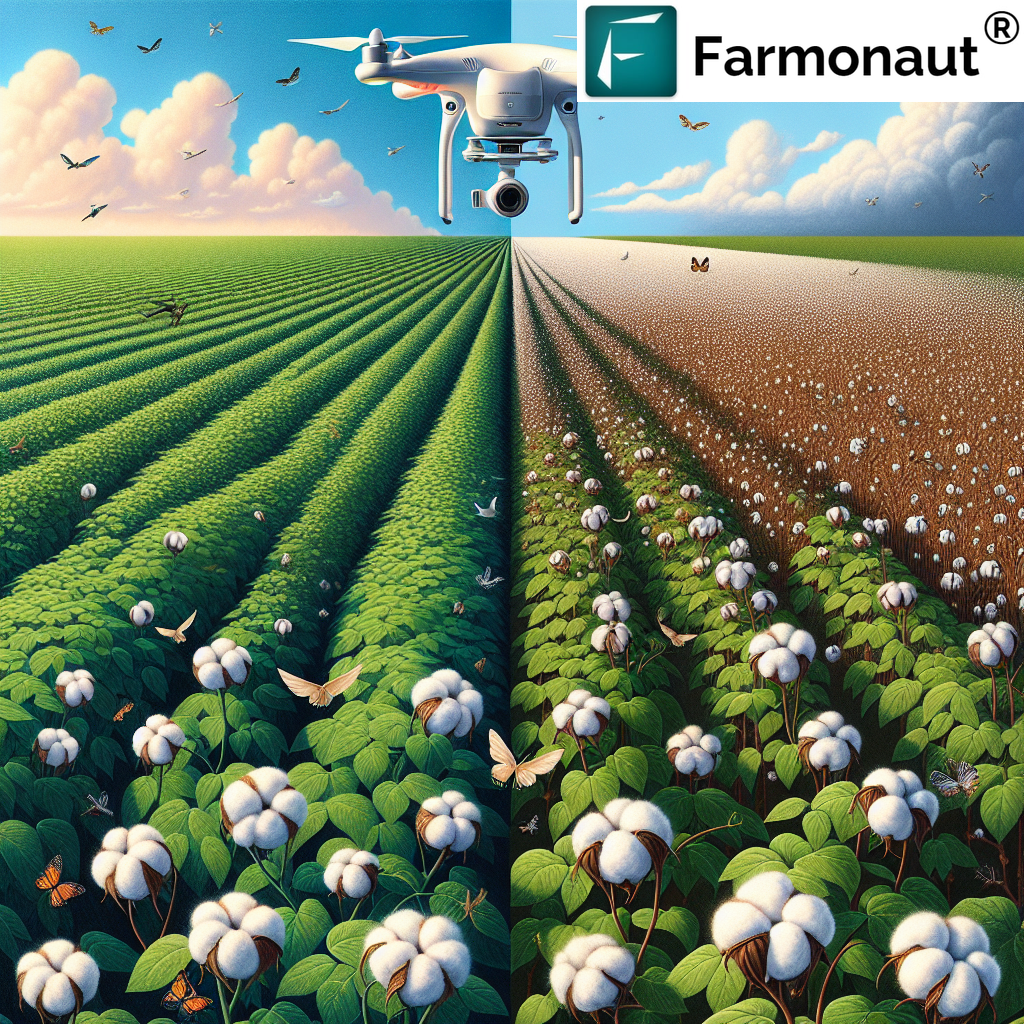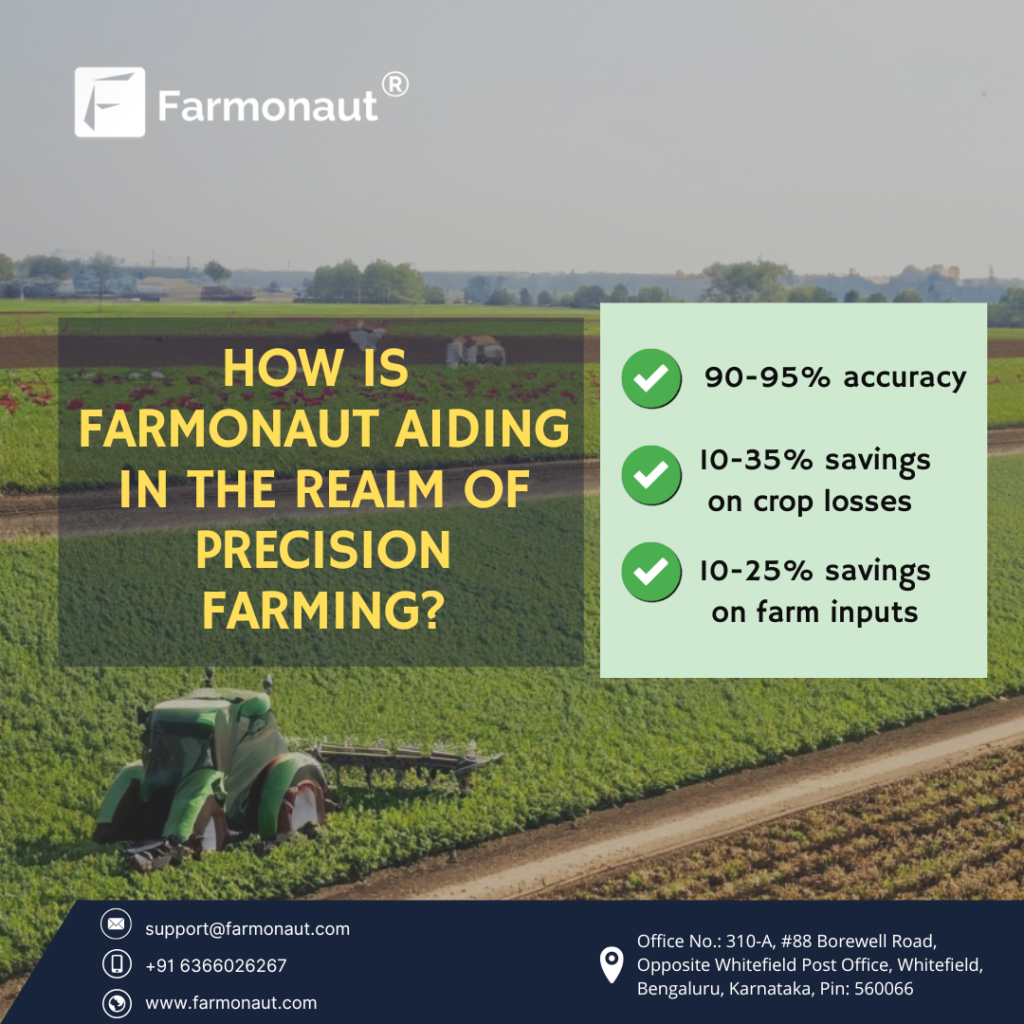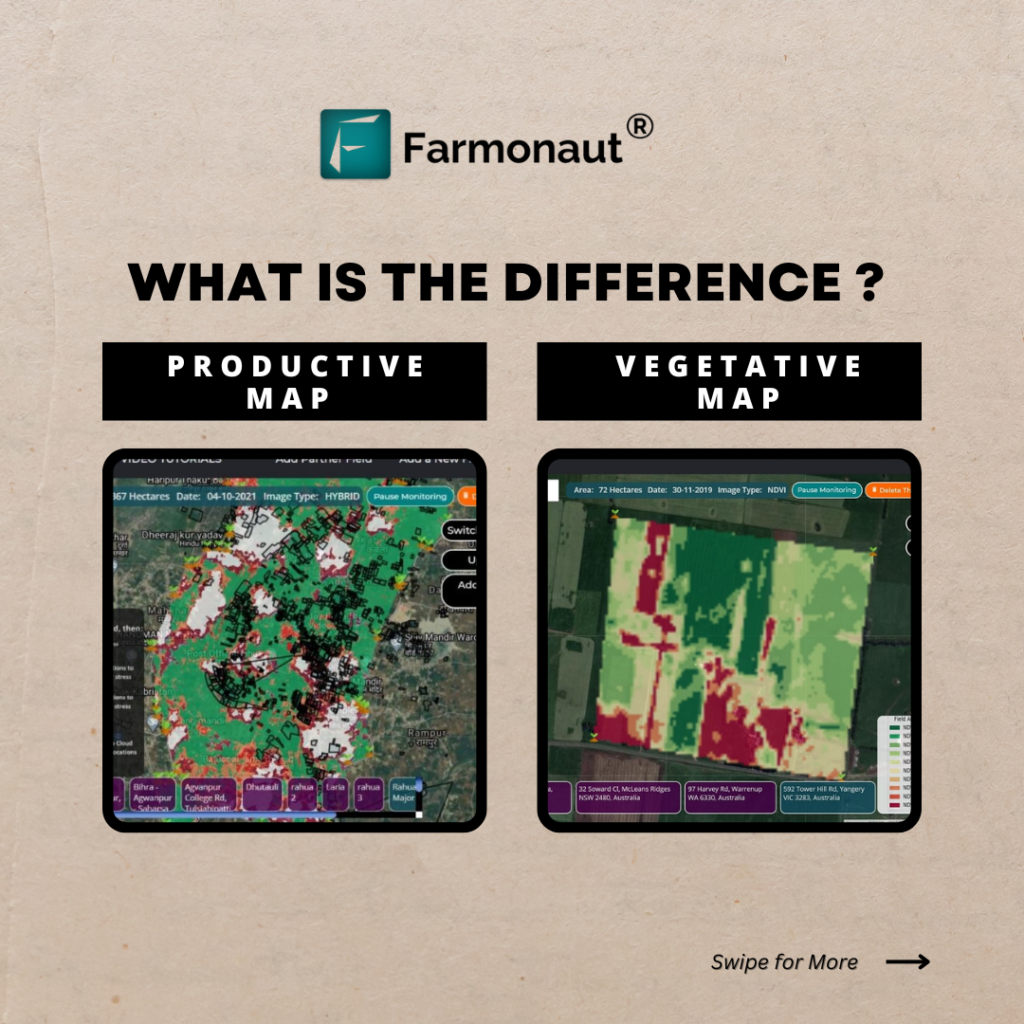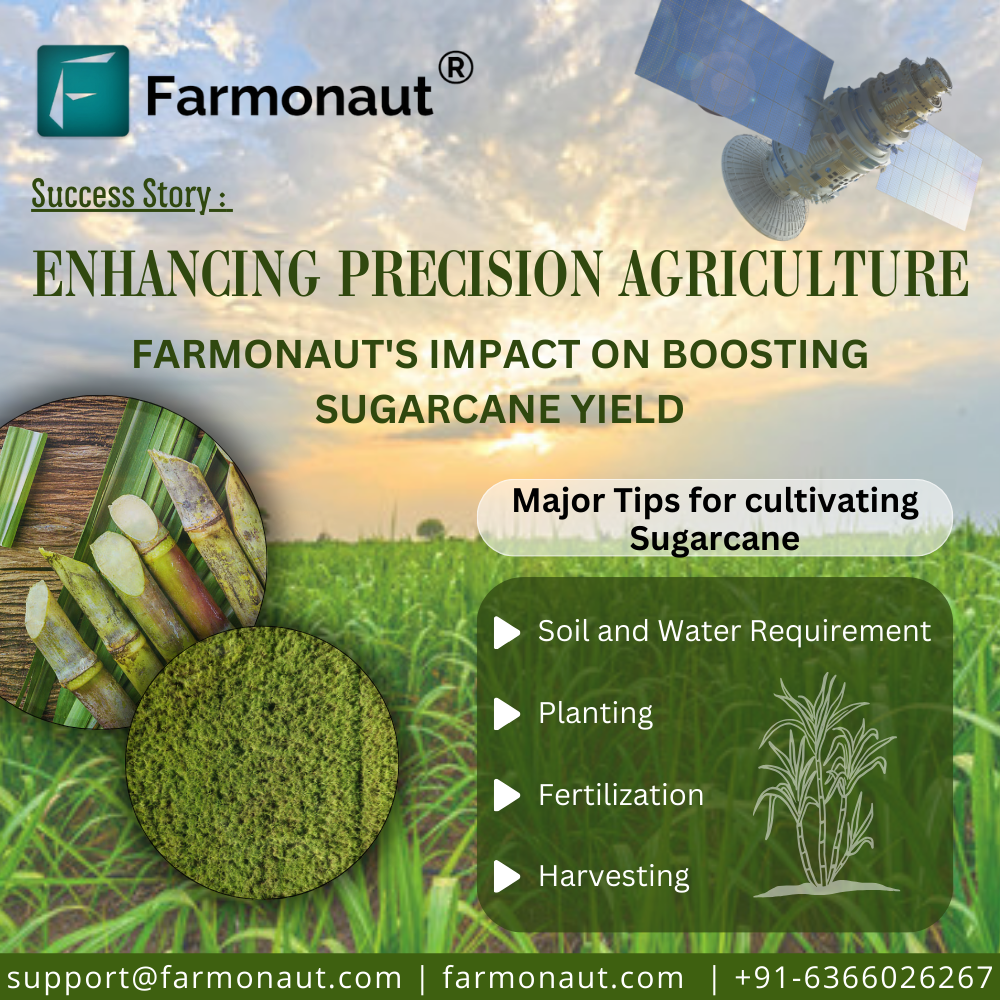Understanding Flared Squares in Cotton: Causes, Prevention, and Management Strategies

As experts in agricultural technology and crop management, we at Farmonaut understand the importance of addressing issues that can significantly impact cotton yields. One such issue that often concerns cotton farmers is the phenomenon of flared squares in cotton. In this comprehensive guide, we’ll delve deep into the causes, prevention methods, and management strategies for dealing with flared squares in cotton, ensuring that you have all the information you need to maintain healthy and productive cotton crops.
What Are Flared Squares in Cotton?
Before we dive into the causes and solutions, it’s essential to understand what flared squares in cotton actually are. Flared squares refer to cotton flower buds (squares) that have opened prematurely and abnormally. This condition can lead to reduced yields and quality issues in cotton production.
Causes of Flared Squares in Cotton
Flared squares in cotton are caused by various factors, both environmental and physiological. Understanding these causes is crucial for developing effective prevention and management strategies. Let’s explore the primary reasons behind this condition:
- Environmental Stress: Extreme weather conditions, such as high temperatures or drought, can trigger flaring of squares in cotton.
- Nutrient Imbalances: Deficiencies or excesses in key nutrients can lead to physiological issues, including flared squares.
- Pest Damage: Certain insects, particularly plant bugs, can cause damage that results in flared squares.
- Plant Hormonal Imbalances: Disruptions in the plant’s natural hormone levels can lead to abnormal square development.
- Genetic Factors: Some cotton varieties may be more susceptible to flaring under certain conditions.
Environmental Stress: A Major Culprit
One of the primary reasons flared squares in cotton is caused by environmental stress. High temperatures and drought conditions can significantly impact the plant’s physiology, leading to premature square opening. When cotton plants experience heat stress, they may respond by shedding squares or causing them to flare open prematurely.
At Farmonaut, we understand the critical role that environmental factors play in crop health. Our satellite-based monitoring system provides real-time data on weather conditions, allowing farmers to anticipate and mitigate potential stress factors. By leveraging our advanced technology, you can stay ahead of environmental challenges that might lead to flared squares in your cotton crops.
Nutrient Imbalances and Their Impact
Proper nutrition is crucial for healthy cotton development. Imbalances in key nutrients can contribute to flaring of squares in cotton. For instance:
- Nitrogen deficiency or excess can affect square development and retention.
- Potassium deficiency may lead to weakened plants more susceptible to stress and square flaring.
- Boron deficiency can cause abnormal flower development, potentially leading to flared squares.
Our Farmonaut platform includes advanced soil analysis features that can help you monitor and manage nutrient levels in your fields. By ensuring optimal nutrient balance, you can reduce the risk of flared squares and other physiological issues in your cotton crops.
Pest Damage and Flared Squares
Insect pests, particularly plant bugs like lygus bugs and cotton fleahoppers, can cause significant damage to cotton squares. This damage can result in flared squares in cotton, as the plant’s natural development is disrupted. These pests feed on the developing squares, causing them to abort or flare open prematurely.
At Farmonaut, we offer integrated pest management (IPM) tools as part of our comprehensive farm management solution. Our satellite imagery can help detect early signs of pest infestation, allowing for timely intervention and reducing the risk of flared squares due to pest damage.
Hormonal Imbalances in Cotton Plants
Plant hormones play a crucial role in regulating growth and development in cotton. Disruptions in hormonal balance can lead to various issues, including flared squares. Factors that can influence hormonal balance include:
- Environmental stress
- Certain chemical applications
- Genetic factors
Our Farmonaut platform provides detailed crop health monitoring, which can help you identify potential hormonal issues before they lead to significant problems like flared squares.
Genetic Factors and Varietal Differences
Some cotton varieties may be more prone to flared squares under certain conditions. Genetic predisposition can influence how a plant responds to stress factors, potentially increasing the likelihood of square flaring. When selecting cotton varieties for planting, it’s important to consider their performance under local conditions and their susceptibility to issues like flared squares.
Farmonaut’s data analytics can help you track the performance of different cotton varieties across your fields, enabling you to make informed decisions about which varieties are best suited to your specific growing conditions.
Prevention and Management Strategies
Now that we’ve explored the causes of flared squares in cotton, let’s focus on strategies to prevent and manage this issue:
- Proper Irrigation Management: Maintain adequate soil moisture to reduce heat and drought stress.
- Balanced Nutrition: Ensure your cotton crops receive the right balance of nutrients throughout the growing season.
- Integrated Pest Management: Implement a comprehensive IPM program to control pest populations effectively.
- Variety Selection: Choose cotton varieties that are well-adapted to your local climate and growing conditions.
- Timely Planting: Plant at the optimal time to avoid exposing young plants to extreme weather conditions.
- Crop Monitoring: Regularly inspect your fields for signs of stress or pest damage.
How Farmonaut Can Help
At Farmonaut, we’re committed to helping farmers tackle challenges like flared squares in cotton through our advanced agricultural technology solutions. Our satellite-based farm management platform offers several key benefits:
- Real-time crop health monitoring
- Weather forecasting and alerts
- Soil moisture tracking
- Pest and disease detection
- Nutrient management recommendations
By leveraging our technology, you can stay ahead of potential issues that might lead to flared squares and other crop health problems. Our AI-powered advisory system, Jeevn AI, provides personalized recommendations based on your specific field conditions, helping you make informed decisions to optimize your cotton production.
Farmonaut Satellite System vs. Drone and IoT-based Farm Monitoring
| Feature | Farmonaut Satellite System | Drone-based Monitoring | IoT-based Monitoring |
|---|---|---|---|
| Coverage Area | Large-scale (entire farms) | Limited by flight time and regulations | Localized (sensor placement) |
| Frequency of Data Updates | Regular (every 3-5 days) | On-demand (requires manual flights) | Continuous (real-time) |
| Initial Setup Cost | Low (subscription-based) | High (equipment purchase) | Medium to High (sensors and network) |
| Maintenance Required | Minimal | Regular (equipment maintenance) | Moderate (sensor maintenance) |
| Weather Dependency | Low (can penetrate clouds) | High (affected by wind, rain) | Low |
| Data Analysis | Advanced AI and machine learning | Varies (often requires separate analysis) | Real-time but limited scope |
As you can see, our satellite-based system offers comprehensive coverage and advanced analytics without the limitations of drone or IoT-based solutions, making it an ideal choice for monitoring and managing issues like flared squares in cotton across large agricultural operations.
Implementing Farmonaut Solutions
To get started with Farmonaut and take advantage of our advanced crop monitoring tools, you can:
- Download our mobile app: Android | iOS
- Access our web platform: Farmonaut Web App
- Integrate our API into your existing systems: Farmonaut API
- Explore our developer documentation: API Documentation
Subscription Options
Ready to take your cotton farming to the next level and effectively manage issues like flared squares? Subscribe to Farmonaut today:
Conclusion
Flared squares in cotton can be a significant challenge for farmers, but with the right knowledge and tools, it’s a manageable issue. By understanding the causes, implementing effective prevention strategies, and leveraging advanced technology like Farmonaut’s satellite-based monitoring system, you can minimize the impact of flared squares and optimize your cotton production.
Remember, successful cotton farming requires a holistic approach to crop management. By staying informed, utilizing cutting-edge technology, and implementing best practices, you can ensure healthy, productive cotton crops year after year.
FAQs About Flared Squares in Cotton
Q: What exactly are flared squares in cotton?
A: Flared squares are cotton flower buds (squares) that have opened prematurely and abnormally, potentially leading to reduced yields and quality issues.
Q: Can flared squares in cotton recover?
A: Unfortunately, once a square has flared, it typically cannot recover. The focus should be on preventing further flaring and maintaining the health of remaining squares.
Q: How can I distinguish between normal square shedding and flared squares?
A: Normal square shedding involves the entire square dropping off the plant, while flared squares remain attached but open prematurely, often appearing distorted or discolored.
Q: Are certain cotton varieties more susceptible to flared squares?
A: Yes, some varieties may be more prone to flaring under certain conditions. It’s important to choose varieties well-adapted to your local growing conditions.
Q: How often should I monitor my cotton crop for signs of flared squares?
A: Regular monitoring, at least weekly during the squaring and early flowering stages, is recommended. Farmonaut’s satellite monitoring can provide continuous oversight to complement your on-ground observations.
Q: Can excessive fertilization cause flared squares in cotton?
A: Yes, over-fertilization, especially with nitrogen, can contribute to flared squares by creating nutrient imbalances in the plant.
Q: How does Farmonaut’s technology help in managing flared squares?
A: Farmonaut provides real-time crop health monitoring, early stress detection, and personalized management recommendations, helping you prevent and address issues like flared squares more effectively.

By leveraging the power of satellite technology and advanced analytics, we at Farmonaut are committed to helping cotton farmers around the world tackle challenges like flared squares and optimize their crop production. With our comprehensive suite of tools and expert insights, you can take your cotton farming to new heights of efficiency and productivity.












